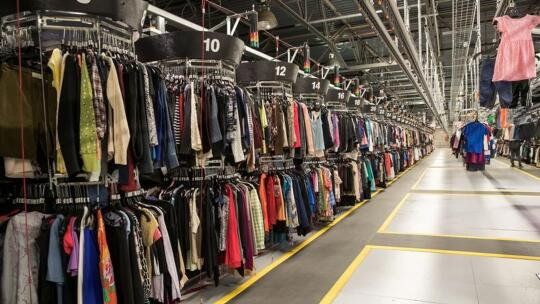Ways to save the environment : Ultimate Guide
If we talk about the ways to save the environment from pollution through sustainability practices and green orientation in the use of resources, we certainly hear about the activities of recycling used and surplus fashion from the needs of its owners, but what does that mean in reality? Let's find out.
What is the definition of fashion recycling?
Fashion recycling (also known as "textile recycling") is an environmentally friendly practice in which textile fabrics, materials and fibres are recycled to create new products.
And when we discuss the ways to protect the environment from pollution resulting from the transformation of textile resources into waste, we cannot overlook the importance of textile recycling, an activity that dates back to the eighth century and continues with remarkable developments to the present time as a result of the development of technology, the expansion of clean energy practices, and the renewal of resource sustainability.
The green trend in preserving resources comes as a result of our resources being a wealth that cannot be recovered if we neglect them, in addition to the fact that the environment has become very affected as a result of wrong practices in which resources are wasted and turned into waste that causes very harmful emissions, which has an impact on the environment in all its aspects, as the soil is affected, and the air is affected, and marine life is affected, as well as, of course, the human being.
The issue and problem of global warming represent a huge threat to the planet, so we must join hands and stand hand in hand for the sake of the world that we all inhabit. Waste of resources and wrong behaviour in the use of resources, including textile resources, poses a threat that poses an immeasurable threat to the environment in all its forms.
The ways to save the environment from pollution have become a question that imposes itself in front of all international institutions. The endeavours towards sustainability, the possibility of renewed use of the resource and the recycling of products in order to provide an opportunity for a second hand, have become a global trend that companies seek to activate through their societal and environmentally friendly role.
Recycling of textile products
The ways to save the environment from pollution are a matter that requires adopting the practices of recycling clothing and textile products as a major approach by relevant institutions and organizations, and this comes through the reuse of clothing and textile materials and preventing them from ending up in landfills.
Environmental benefits of recycling in the fashion industry
We can realize that recycling clothes is an activity that extends their life cycle and reduces their transformation into waste that is very harmful to the environment. Simply put, you can know that 18.6 million tons of clothes are sent to landfills every year! And once it starts to decompose:
Natural fabrics produce methane and other harmful gases that contribute to the negative impact on the climate.
Synthetic fabrics do not completely decompose for centuries, resulting in extremely harmful emissions to the environment.
Therefore, the activities of recycling clothes and converting products into renewable resources represent an effective option that solves the problem in an unlimited way.
Pros of recycling activities of fashion and textile products
Recycled textiles provide an alternative to newly manufactured fibres, saving energy and water.
Protection from dyes, which are a major cause of water pollution and often include toxic substances.
Problems and Challenges of fashion recycling activities
Some clothes are difficult to recycle and they won't be enough to cover the market anyway.
When cotton is mechanically recycled, the fibres become shorter and of lower quality - so they last less.
A lot of clothes aren't made for recycling.
200 billion items of clothing are sold annually and are worn only 7 times before being thrown away and less than 1% of them are recycled.
Related recycling also results in greenhouse gas emissions and high demand for water use.
Nevertheless, recycling is definitely better than producing new materials and fabrics from scratch!
Environmental protection practices to be followed in textile manufacturing
As for the ways to save the environment from pollution, clothing design should be recyclable and green-to-green.
Choosing materials that are most easily sustainable and when using chemicals, we have to choose less negative materials that don’t affect sustainability.
We are extending the life cycle of the product by keeping it in circulation for a more extended period.
Consumer practices towards a sustainable textile resource
Towards what is about the ways to save the environment from pollution; It is important to choose clothes made from textiles that can be recycled positively, thus contributing to reducing the negative impact on the environment.
Go to recycling centres and institutions such as Kiswa and dispose of surplus clothes positively.
Preserving the product in the best way so that it is not wasted is an approach that keeps the resource from being wasted.
Do not leave clothes stacked in a closet, box or bag without making them reusable through recycling practices.
How can we contribute to Kiswa with a positive role in saving the environment?
In Kiswa and with our international and regional presence, we seek to activate the practices of recycling textile products by motivating communities to adapt their surplus clothes towards recycling and giving textile resources oxygen that makes them live again and not end up in landfills.
The ways to save the environment from pollution are a matter that prompts us to activate all positive practices that achieve positive results within the framework of our tireless work with all our customers. Therefore, we have partnered with a group of documented charities that provide a helping hand to civil society for human solidarity in which those in need are helped. And the least fortunate in terms of financial ability.
Along the way, Kiswa launches initiatives in cooperation with institutions and bodies of all kinds in order to shed light on the importance of environmental protection activities, support for clean energy and green orientation for a sustainable environment in which the use of resources is renewed and their life is extended because they are our true wealth.
Kiswa's philosophy is to protect the environment
The ways to save the environment from pollution are a basic trend for Kiswa and its effective activities in various GCC countries are activities that reflect this orientation, and our work is based on an institutional approach that adopts sustainability mechanisms as a civil and societal option that must be strengthened. We direct children in schools, employees in agencies, housewives And other groups of society so that the practices of preserving resources and preserving the environment are automatic practices that the individual gets used to in our societies because environmental awareness is worthy of knowledge and practice.
When we talk about textile resources, you can know that it takes nearly 200 years to completely decompose, while throwing clothes and textile products in the trash and turning them into landfills, these wastes emit toxic gases and emissions that are extremely harmful to the various elements of the environment, harming marine life, Wildlife, the atmospheric environment, with its effect on fish, animals, birds and, of course, people.
The global warming crisis also represents a major problem, and textile waste represents a major supporter of this problem, which exacerbates the crisis. Therefore, we have to take a proactive step and not justify the issue by the lack of influence of one individual on solving the problem. Our cooperation together and the individual role played by any person in the world represent a positive impact on the issue as a whole for a better outcome and an improvement in the state of the environment in terms of purity and sustainability. Therefore, the approach Green is one of the livery trends for a planet that expands eco-friendly activities.




_20240325114503000ItBbKdoZu7.webp)
_20240325115249000UirOdThkkG.webp)
_20240325115505000Ykx8WHs73s.webp)
_20240325115934000UukQIBaw2h.webp)
_20240325120255000zpwtHKUqlm.webp)
_20251120180713000zPMqgrjY0I.webp)
